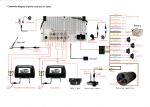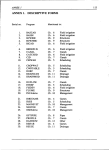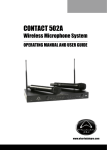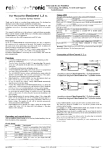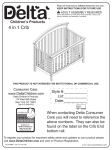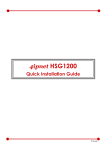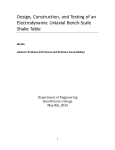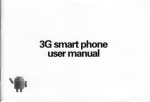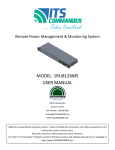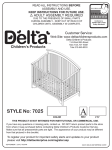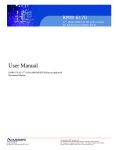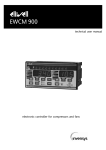Download Caretaker User Manual
Transcript
Congratulations! Your purchase of the C a r e T a k e r security system is a decision which will afford you greater peace of mind for the many years of service the system is designed to provide. The CareTaker is a revolutionary security system that allows you to use your Touch T o n e telephones to control your system and receive voice responses to your commands. It provides sophisticated protection without complex control panels with dozens of lights, bells and whistles. This manual consists of four sections: SECTION 1 introduces you to the components of your CareTaker system. SECTION 2 shows you how to turn the intrusion protection on and off and explains what to do if you create a false alarm or experience a problem with your CareTaker. SECTION 3 explains some additional advanced and optional features you may wish to explore once you have mastered the day-to-day features in Section 2. SECTION 4 contains a Glossary of Terms (please review them before trying to operate your system), important information regarding the limitations of your system and what you should know about Federal Communications Commission Rules Part 15 and 68. Special Note: Some of the features of CareTaker talked about in this manual are optional and are available at additional cost from your CareTaker dealer. Arming Level 3 Automatic Test bypass 20,2 I, : Central Station Chime 35 Communication Controlled Ligh Delayed Entry/I Detailed Full St Detection Sense Door/Window S Duress Code 36 Energy Saver 21 Energy Saver R ENERGY SAV Entry/Exit Path FCC 40 FCC Part 68 Nc Full Status Ann HELP 16.36 Instant 36 Part I5 of FCC Radio and Telev Radio-TV Interf REN 41 RJ-31X jack 41 Sensor Test 36 Short Status 36 Smoke Sensor ! Sound Sensors 1 Telephone Oper Touch Tone Phc Trouble Signal This section explains whar each of the system’s components do. . SYSTEM COMPONENTS The CareTaker Central Processing Unit (CPU) Touch Tone Phone Wireless Touchpads Wall Mounted Wired Touchpad With Speaker Interior Sirens Exterior Siren/Speakers Energy Saver Module l DETECTION SENSORS l Dour/window Sensor l Passive Infrared Sensor l Sound Sensor l Shock Sensor l Smoke Sensor l Heat Sensor The CareTaker Central Processing Unit (CPU) The CPU contains the electronic microcomputer circuits that control your system. It receives information from sensors placed strategically throughout the building and commands from Touch Tone phones or your Touchpad. It sounds sirens and siren speakers and produces voice announcements over your phones and can report alarms to the Central Station. The CPU has two indicator lights visible through small windows on the front panel. l System OK Light (Green) l Armed Status Light (Red) The CPU is typically mounted in a secure area out of normal view as there are no controls or indicators on the unit which are essential for day to day operation. The cabinet is equipped with a lock to prevent unauthorized tampering. The unit is powered by a plug-in external transformer which means there are no hazardous voltages in the cabinet or elsewhere in the system. This CPU is required for use in an Underwriters Laboratories Listed household Fire and Burglary Warning System. Touch Tone Phone CareTaker can be operated from most Touch Tone telephones. You simply push the buttons on your Touch Tone phones in a special sequence to turn on or off most CareTaker features. You will also hear voice announcements concerning your system from your phones ear piece. Only Touch-Tone Phones should be used with CareTaker. To check to see if your phone is Touch Tone, notice if you hear a tone each time a dialing button is pushed. Some push button dial phones are pulse dialers and you will hear a series of faint clicks instead of tones when you dial. In addition, the m and m buttons must not be used for another purpose that will interfere with CareTaker’s operation. CareTaker does not interfere with normal use of your phones with two exceptions: (1) If your system detects a trouble condition CareTaker will make a brief announcement reminding you of the problem when you are about to place an outgoing call. This announcement will be repeated at least once a day, again when you place a call, until the trouble is fixed. (2) If an alarm or test is in progress and the CPU is reporting lo the Central Station, all telephones will bc temporarily disabled and any calls in progress will be disconncctcd. 3 NOTES Interior Sirens are small, permanently mounted sounding devices. One model combines the siren and a telephone jack and replaces an existing telephone jack. The other model is a siren only. These devices will sound the various system status beeps as well as make louder alarm sounds in Ihe event of an audible alarm. One model 60-136 indoor siren is required for use in an Underwitcrs Laboratories Listed household fire and burglary warning system. Exterior Siren/Speakers CareTaker has two models of extra loud speakers that may be placed outside (sometimes inside) of your building. When activated they emit a loud siren sound and using the CareTaker digitized voice will announce the type of alarm and the number of the sensor which detecled it. The noise will usually frighten an intruder as well as alert neighbors and help you determine the cause of the alarm. 4 LIGHT AND TOUCHPADS In addition to operating your CareTaker system with Touch Tone phones, you have your choice of three different Touchpads. You can have any quantity or combination of Touchpad models in your system. Status Light, System OK ON.... S: Blinking OFF.... : Wireless Touchpads Two Wireless Touchpad models are available (models 60-144 & 60273). One is designed to be attached to the wall. The other, a hand held model, can be carried about. Both can be used to turn CareTaker on and off as well activate emergency panic (HELP) alarms. Note: Wireless Touchpads are not capable of arming the system if a trouble condition exists. You must use a Touch Tone phone or the Wired Touchpad. Armed Stat1 ON.... A Blinking OI?F....A Trouble Lig OFF.... Flashing (Call Energy Sav OFF-E run1 ON.... E Siren Sound Alarm Loud SL Loud in Status Eight lo One, tw Lonrz Very 101 dot Very sh ape 5 Wall Mount Wired Touchpad With Speaker A Touchpad (model 60-258) is available with a built-in voice message speaker and siren, In addition, four lights indicate the status of the system and the energy saver as well as the armed status and the existence of trouble conditions. The unit must be wired to the Central Processing Unit by a qualified installation technician. The Model 60258 Keypad is required to be used in an Underwriters Laboratories, Inc. Listed Household Fire and Burglary Warning system. - TROUBLE BUTTON - Push to get messages and silence trouble beeps. ON when intrusion protection is in level 3. STATUS - FLASHING when intrusion protection is in level 2. OFF when intrusion protection is OFF SYSTEM OK - On when OK, OFF when service is required. \ - TOUCHPAD. Use like a Touch Tone phone. TROUBLE - ENERGY SAVER - Flashes when a message is waiting. ON when you turn on Energy Saver feature. 6 “HELP” Buttons. Push both at once and hold lo send a ‘HELP call. FCC AND'I w ENERGY SAVER MODULE 60-140 This optional device contains a temperature sensor which is wired to the CareTaker and a control which is connected to your thermostat. You can set high or low temperature limits in CareTaker’s memory using a Touch Tone phone. When the Energy Saver is turned on it replaces your thermostat and the preset temperature becomes your new thermostat setting. You can turn the Energy Saver feature on or off with a simple command when you arm or disarm system. You can also control the Energy Saver feature from an off premise telephone. Radio and Tel This equipment hi requires the follov This equipment gc in strict accordant reception. It has b accordance with tl reasonable protec guarantee that intr to radio or televis couraged to try IO In addition, the unit contains a freeze warning device which is and normally set at 42 degrees. In colder climates this feature can alert someone, using the communicator, of a furnace failure. You can also call your CareTaker from a remote phone and have the current temperature announced by requesting the detailed status report. l Note. On the Hardwired Touch Pad, the Energy Saver light will normally come ON when you turn the Energy Saver feature ON. It may not be ON when you return to turn the feature OFF however, because the light turns OFF while your furnace or air conditioner is running. If using an ir , Re-orient the Move the ret Move the an1 Plug the car branch circu If necessary, the tional suggestion! Commission, he1 “How to Idel This bookle Stock No. ( 7 DETECTION SENSORS There are numerous sensors which are compatible with CareTaker particularly because the unit can accept both the wired and wireless types. Your CareTaker dealer will suggest the units he feels best suit your security needs. Following are descriptions of the more popular wireless sensors for use with the system. Door/Window Sensor 60-135 This two piece sensor can detect any opening of doors, windows, cabinets, etc. It consists of a battery powered radio transmitter and a magnet. The units are mounted so that when the door or window is opened, the magnet is separated from a sensitive magnetic switch in the transmitter unit causing an “open” or alarm signal to be sent to the CPU. Motion Sensors (Not to be used in a U.L. Installation) Motion Sensors detect movement of body heat within their detection pattern. They are used indoors only and are usually placed in an area in which an intruder would likely go if hc were to gain entry. The Motion Sensors contain a built in radio transmitter to alert the CareTaker CPU when an intrusion is detected. Sound Sensors (No1 to be used in a U.L lnstallation) Sound Sensors detect only the intense sounds of breaking glass or splintering wood caused by a forced break-in. 8 Shock Sensors (Not to be used in a U.L. Installation) Shock Sensors mount on window frames and detect the shock caused by an intruder who breaks though a window lo gain entry. Smoke Sensors 60- 106 Smoke Sensors should also be a part of your protection system. In a home it is desirable to have at least one on each level of the home and particularly important to have one near all bedroom areas. Heat Sensors (Not to be used in a U.L. Installation) Heat Sensors are used to detect fire in areas not suited for smoke sensors such as kitchens or garages. Replacement Battery Guide When replacing batteries in this equipment, please use the batteries recommended below. Transmitter Part # Battery, Manufacturer 60- 144 Wireless Touch Pad LS-3 SAFT, Rated 3.5V lithium** 60-273 Wireless Touch Pad LS-3 SAFT. Rated 3.5V lithium** 60- 135 Door / Window Sensor LS-3 SAFT, Rated 3.5V lithium** 60-106 Wireless Smoke Sensor MN1604 Duracell, Rated 9V Alkaline ** This lithium battery is available only from your servicing ITI Dealer. 9 AUTOMATIC TEST FEATURES When to Use: l What Will Happen: l Your CareTaker system has several automatic test routines builtin. If CareTaker discovers a problem it will notify you. Call your dealer to discuss what to do. The Sirens will beep, rapidly, eight times every minute until you pick up the phone or push the “Push When Flashing” button on a Wired Touchpad and listen to the trouble message. These same eight beeps may occur again 12 hours later if the problem is not corrected. The Green System OK Light on the CPU will blink until the trouble is corrected. When you change the arming level or make a status request you will hear the trouble beeps following the regular arming level beeps. If your system is monitored, the Central Station will be notified of the problem. Your telephone will make a “Ping Pong” sound and announce the particular test failure as follows: “AC Power is Off...” Your system may have accidently been unplugged or disconnected from AC power. ‘System Battery is bad...” The emergency standby battery has failed and should be recharged or replaced. “Sensor ?? Failure...” The particular sensor is probably not working. “Sensor ?? Trouble...” A sensor has an internal problem such as a low battery or the cover is off. It may still be working. “Trouble Code Zero Zero...” The system has not been programmed or its memory has been cleared for some reason. “Trouble Code 96... ” Your telephone line or connections are bad. The audible alarm features of your system will still work but the communicator will not. “Fire Sensor ?? Trouble...” A fire or smoke sensor has not properly reset after activation. “Phone Line Failure...” Your telephone service is not working or the CareTaker has been disconnected from the phone line. 18 TURNINGTH When to Use: This section tells you how to use additional features of CareTaker What to Do: The following is a brief description of the features you will learn about in this section. They are listed in the order in which they appear. . Bypass . . . . . . . . . . . Deleting an open intrusion sensor which would otherwise prevent the system from arming. Direct Bypass -“Turning off’ a “special 24 hour intrusion sensor” or any other intrusion sensor. Instant - Changing delayed intrusion sensors to Instant when arming your system. Chime -Turning the Chime feature on and off. Lights - Extending exit timing of Controlled Lights to 5 minutes and turning Controlled Lights on for 5 minutes from a telephone or Touchpad. Alarm History - Listening to the Alarm History messages stored in CareTaker. Energy Saver - Turning the Energy Saver on when arming your system. Central Station Test - Performing the Central Station test. Sensor Test - Performing the Sensor Test for each sensor in your system. Energy Saver - Turning the Energy Saver on or off without arming or disarming your system. Energy Saver Temperature - Setting s the Energy Saver low or high temperature set point. Wired Touchpad - An illustration showing special features of the optional Wired Touchpad. . Disable Access - Temporarily turning off CareTaker response to the m and m buttons on your phone so that you can use these buttons for other purposes. . Off Premise Access - Controlling your system from an off premise phone. . Duress Code - Entering this special code generates an emergency silent alarm while disarming or arming your system. What Will Happ Notes: LIGHT AND SOUND SUMMARY Status Lights System OK Light.... Located on the CPU cabinet and the Wired Touchpad. ON.... System condition is normal. Blinking.... A trouble condition exists. Listen to announcement on phone. OFF.... System Failure. Call your dealer. Armed Status Light... . Located on the CPU cabinet and the Wired Touchpad. ON.... Armed to Level 3. All intrusion protection is ON. Blinking.... Armed to Level 2. Perimeter intrusion protection is ON. OFF....Armed to Level 1. Intrusion protection is OFF. Trouble Light.. . . Located on the Wired Touchpad. OFF.... Normal. Flashing.... A trouble condition exists. Push button near light for message: (Call for service if trouble condition exists.) Energy Saver Light.. . . Located on the Wired Touchpad. OFF....Energy Saver feature is OFF. (Also OFF when furnace or air conditioner is running even though Energy Saver may actually be ON.) ON.... Energy Saver feature is ON. Siren Sounds Alarm Loud steady siren.... Fire alarm. (Takes precedence over burglar alarm.) Loud intermittent siren.... Intrusion or HELP alarm. Status Eight low volume beeps every minute.... A trouble condition exists. One, two or three low volume beeps.... CareTaker is acknowledging that you have armed lo Level I, 2, or 3. Long (one second) low volume beep....CareTaker is acknowledging your command. Very long, low volume beep.... CareTaker is “protesting your attempt to arm because a door or window is open. Very short, low volume beep.... The Chime feature is announcing a door or window opening. 42





































